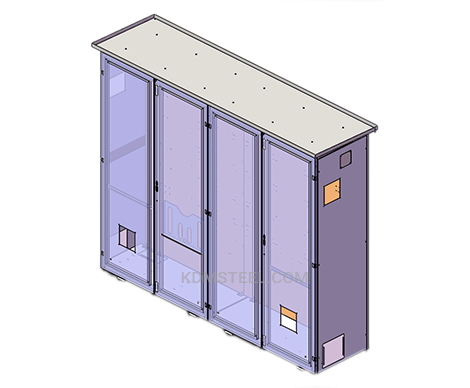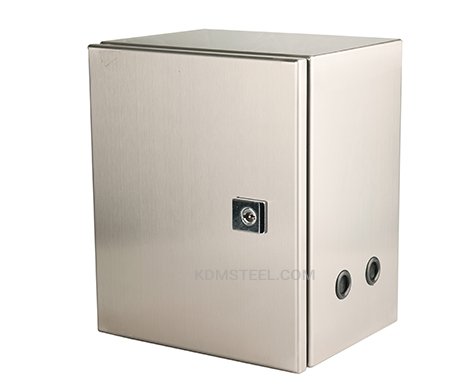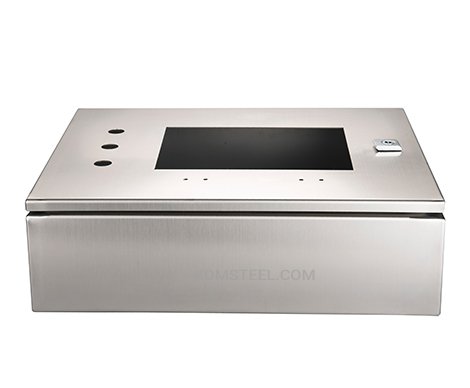- Custom Ip56 or Any IP rating Enclosure
- Certificación IP65/IP66
- Producción rápida de muestras en 3 días
Custom IP56 Enclosure Manufacturer in China
KDM IP56 enclosure is specially designed for industry and factory automation, heavy-duty vehicles, outdoor kiosk, swimming and spa pool kiosk, toilet AD display, and medical equipment. This enclosure undergoes rigorous testing against harsh environments such as water jets, rain, flood, salt fog, moisture, severe dust, and dirt exposure.
Small quantities of dust can enter the enclosure, but the quantity of dust cannot impact the operation of the equipment.
KDM IP56 Enclosure Series
Send your Inquiry on KDM IP56 Enclosure


KDM IP56 enclosure is manufactured using the highest quality materials, which ensures excellent insulating properties and a high level of resistance to chemical and mechanical influences.
KDM IP56 enclosure is resistant to heat, shocks, atmospheric agents, and UV rays. The right choice of materials is a core competence of KDM engineering and design capabilities.
- Capacidad de fabricación
- Guía de compra

Máquina de corte láser de alto rendimiento de 4000 W, precisión de +/- 0,05 mm. Sin rebabas ni rayones.

Equipo de soldadura flexible multifunción, alta precisión, sin deformación.

Precisión de doblado de +/- 0,5 mm, superficie lisa sin marcas de doblado.

Más de 10 trabajadores con experiencia en soldadura, apariencia general perfecta.

Máquinas de espumado de alta velocidad y precisión, empaquetadoras rápidas y calificadas.

El equipo de montaje experto, calidad de montaje constante en cada carcasa KDM
KDM IP56 Enclosure
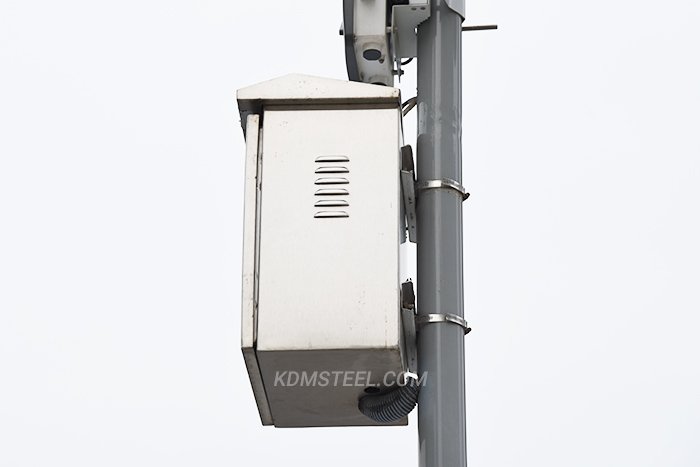
Stainless Steel IP56 Enclosure
We, at KDM, provide enclosures range of electrical enclosure including pole mounts, wall mounts, floor mounts, free-standing, lockable, modular and more. These enclosures can vary in size, from relatively small street-side cabinets to large walk-in cabins located trackside greenfield sites, street-sides, etc.

KDM IP56 Enclosure Factory

IP56 Enclosure Welding
IP56 enclosure designed to satisfy customer needs, precisely engineered & carefully manufactured by KDM. KDM features a reliable and long lifetime and versatile IP56 enclosure mechanical design. KDM IP56 enclosure protects people who come in contact with the component. Besides the protection mention above, the IP56 enclosure also adds protection from splashing water, horse-driven water, snow, and corrosion. IP56 from KDM offered in high standards and at the same time can be customized to meet your specific application requirements.
KDM electrical enclosure that meets IP56 standards can be customized. Custom IP56 products can be painted in any number of colors or color combinations. Also, you can choose the materials, finishes, shapes, sizes, holes, and cutouts, in each of these, we can handle with expertise. We design and manufactures custom IP56 enclosure according to customer’s requirements to meet their exact job needs.

At KDM, we present your wide variety of electrical enclosure meeting IP56 standards. Our large range of innovative enclosure solutions supplemented by a vast selection of accessories. With the immediate availability of products, your product can be individually adapted to fit any of your applications. The KDM range of IP 56enclosure has been on the market for over 10 years.
KDM as a premier manufacturer with a strong customer service approach, our extensive experience, in designing, engineering, and manufacturing capability enables us to meet the advancing needs of our clients. IP56 enclosure quality is essential to ensuring longevity and value for your money, which is why we strive to supply customers with high-quality, durable products that will stand the test of time.

With 10 years of manufacturing experienced, KDM has a team of the most creative & highly skilled professionals who use optimum quality raw materials and innovative technology in manufacturing. Our IP56 enclosure is crafted as per the standard guidelines and stringently tested on various quality parameters by our expert quality controllers. So you can guarantee that our IP56 enclosure is convenient, user-friendly and quality assured.
For further details in our IP enclosure, contact us today!
The Definitive FAQ Guide to IP56 Enclosures
- What does the IP code mean?
- What does IP56 mean?
- What is the difference between IP55 and IP56?
- What is associated with the letters after the main IP code?
- What testing do IP56 enclosures undergo?
- Can IP56 standards be converted into any NEMA type?
- Are IP56 enclosures explosion-proof?
- Do IP56 enclosures protect against corrosive agents?
- How do IP56 enclosures deal with thermal hazards?
- Where can IP56 enclosures be used and for what applications?
- What designs of IP56 enclosures can I choose from?
- How many doors can an IP56 enclosure have?
- What features can I request for IP56 enclosures?
- What accessories can I request for IP56 enclosures?
- Do locks, windows, vents, and hinges lower the IP rating?
- What different types of steel can be used for IP56 enclosures?
- Is fiberglass a good material for IP56 enclosures?
- Why use aluminum for IP56 enclosures?
- What paints and coatings can be used for IP56 enclosures?
- How do you customize the symbols or writing on an IP56 enclosure?
What does the IP code mean?
The IP code stands for Ingress Protection. It is also known as IEC standard 60529.
It is called EN 60529 in Europe.
It consists of 2 numbers after the IP.
The first number corresponds to the level of protection against the ingress of solids, whereas the second digit corresponds to the ingress of liquids.
For dust, the numbers go from 1 to 6, and for liquids, they go from 1 to 9K.
Enclosures with a dust rating of 1 would protect against anything that is bigger than 50 mm, or 1.9 in.
On the other hand, enclosures that are fully dust-tight protect against any solid particles.

IP chart
Enclosures with a liquid rating of 1 are effective against dripping water in an upright position, thus, they are protected against rain.
Meanwhile, 9K enclosures are able to withstand pressurized jets of hot water.
There can be a zero marked, which means no protection.
There can also be an “X” mark, which usually means that any number can be put there.
There can be other lettered markings as well.
What does IP56 mean?
Enclosures rated with IP56 are protected against limited dust ingress, and from high-pressure water jets from any direction.
Limited dust ingress refers to the fact that most dust cannot enter the enclosure, but a small quantity of it can.
However, the dust that does manage to get through is not enough to damage the electrical components of the enclosure or disrupt its work.
High-pressure water jets can be measured at 100 liters per minute and could be heavy rain, water spray from nearby machinery or marine environments.
IP56 enclosures are also stronger in environments with chemicals and corrosion since it has a good weather-proof rating.
Especially, IP56 enclosures are able to withstand the heavy seas, so they can be put in beachy locations, on ships, or near pools.
Also, places with fog and humidity will be okay as well.

IP56 enclosure
What is the difference between IP55 and IP56?
These two IP ratings are exactly the same in terms of dust protection, but IP56 can take on pressurized water jets, whereas IP55 is good only for splashes and low-pressure spray.
Both are very similar, but if your business involves a lot of water, then IP56 is better than IP55.
What is associated with the letters after the main IP code?
As we already mentioned the “X” means that there is no available information, or that it is irrelevant or replaceable.
There are 2 sets of optional letters you can add after the digits.
The additional set – A, B, C, D – describes the protection of the enclosure against tampering.
A stands for protection against the back of a hand; B stands for protection against a finger; C stands for protection against access with a tool, while D indicates for protection against access with a wire.
The supplementary set of letters – H, M, S, W – tell the user what the enclosure is for.
H tells that the enclosure can serve for a high-voltage device; M indicates that the device inside the enclosure was moving during a water test, whereas S means the opposite – that it was standing still.
Finally, W means that the enclosure is weather-proof.

The full IP code
You can use these to indicate what features you want your IP56 enclosures to have.
These are mainly used for better communication between the client and the manufacturer.
What testing do IP56 enclosures undergo?
IP5X is tested using a closed space where a vacuum attracts a lot of dust and different powder that is blown all around to the enclosure for 8 minutes, and then the enclosure is checked for dust ingress.

Dust chamber testing
IPX6 is tested using spray nozzles, measured at 12.5mm, with oscillating tubes that pressurize and spray water at 100 liters per minute for 5-10 minutes in any imaginable angle.
IP56 enclosures can also be submerged underwater for 2 minutes.
Can IP56 standards be converted into any NEMA type?
As for Normativa nacional, we offer any type, starting with 1 and up to 13, including subtypes, such as 3X.
Our Cajas NEMA are protected against weather, corrosion, coolant seepage, chemicals, and much more.
IP ratings and NEMA types cannot be directly converted into one another, but they can be loosely compared as shown below. ZZZZ

NEMA and IP rating comparison
As the table shows, there is no direct comparison, but there can be a close resemblance between IP56 and NEMA types 3, 3X, 3S, and 3SX.
Types 12, 13, and 5 are also fairly close.
These types are often used outdoors, protecting against rain, dust, snow, and sleet.
It is often used with junction boxes.
The type 3X is extra corrosion-resistant. Type 3S is aimed to protect from ice.
And, type 3SX has both properties.
Thus, you can get all these properties with IP56 as well.
Are IP56 enclosures explosion-proof?
Unfortunately, IP56 enclosures are not strong enough to contain an explosion or an arc flash.
They are not comparable to NEMA types 7, 8, 9, or 10.
These enclosures need to withstand high impacts and high temperatures.
As for arc flash, enclosures typically can’t protect from that, so personnel needs to keep that in mind.
However, if you need an explosion-proof enclosure, Contáctenos and we will engineer it for you!
Do IP56 enclosures protect against corrosive agents?
IP56 is not fully waterproof, so it may not protect against corrosive agents if they are strongly sprayed on it or submerged in.
If they are just splashed, or even sprayed, then there is no problem, but corrosive fumes may still get in.
The material plays its role as well – aluminum and stainless steel are the most corrosion-resistant materials.
How do IP56 enclosures deal with thermal hazards?
KDM IP56 enclosures are equipped with double-wall technology, a thermal chamber, insulation, heat strips, heat exchangers, and vents with air conditioning.
All this provides protection from the electrical heat and solar radiation to prolong the life of electrical components within the enclosure.

Double-wall technology
Plus, thermal management reduces hot spots, equalizes pressure, and minimizes condensation, which can damage electronics and various devices.
Where can IP56 enclosures be used and for what applications?
IP56 enclosures can be used both indoors and outdoors in non-hazardous environments.
IP56 enclosures are commonly used in industry and factory
machinery/equipment, heavy-duty construction, swimming and spa pools, bathrooms, transformers, and medical equipment.
Some other applications include medical equipment, like a CPR machine, and even medications.
Other applications may be telecom cabinets or control boards, among other things.
This IP rating is perfect for outdoor environments because it is rain-proof and sufficiently protected against dust ingress.
IP56 enclosures are also well protected against tampering, just as any IP5X enclosure is.
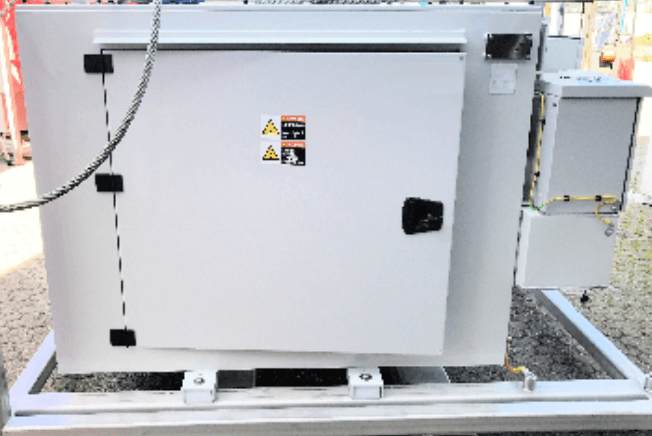
IP56 outdoor enclosure
What designs of IP56 enclosures can I choose from?
We are pleased to offer you countless designs of free-standing enclosures, floor-mounted, wall-mounted enclosures, modular enclosures, junction boxes, and custom enclosures.
Free-standing enclosures are perfect for large electrical units that are too heavy to be wall-mounted or pole-mounted.
They could be of any height and width.
They are also portable and can be walk-in enclosures.

Recinto independiente
Floor-mounted enclosures are very similar to free-standing enclosures, only floor-mounted ones are secured to the floor – thus, they are not portable.
If you are mounting them into concrete, a guide plate or pedestal is needed.
Wall-mounted enclosures use mounting brackets, screws, and pads.
They are perfect for small devices, and thus are cost-effective.

Caja de montaje en pared
Modular enclosures are highly versatile and can be switched around, which is great for any application.
Junction boxes and operator interfaces are usually enclosures on a stand.
They have user-friendly layouts, are great for small electrical units, and can be portable.
These are the most common with IP56 enclosures that are used for control panels.

Caja de conexiones
Of course, we also have our custom enclosures, which can be of any design, shape, and requirements.
How many doors can an IP56 enclosure have?
Single doors are perfect for smaller and less complex electrical units, whereas double doors are used for large and complex units.
Multiple doors are used for huge industrial applications or for increased security.
If you would like a consultation on our designs, you are welcome to reach out to us!
What features can I request for IP56 enclosures?
Puede solicitar ventilaciones, ventanas, puertas batientes, cerraduras, sistemas de gestión de cables y mucho más.
RespiraderosAdemás de los ventiladores radiantes, proporcionan una vía para que escape el calor, enfriando los componentes eléctricos del gabinete.
Esto prolonga su vida útil y disminuye la posibilidad de fallos de funcionamiento.
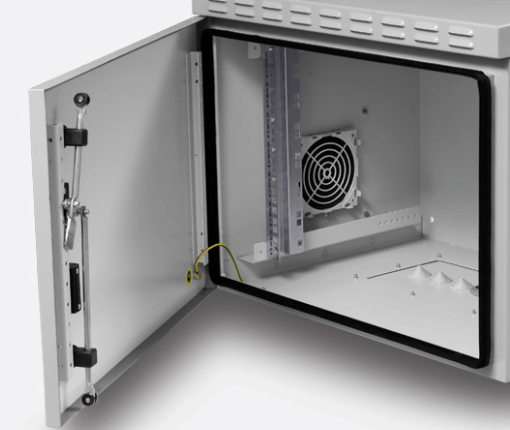
Ventilador radiante en un recinto
Éstos también estabilizan la presión del aire dentro del gabinete, evitando la condensación que puede dañar los componentes eléctricos del gabinete.
Plus, the vents can be further upgraded to air conditioners and heat exchangers.
Ventanas Ayudar al personal a examinar los componentes eléctricos de forma rápida y no invasiva.
Y si algo sale mal, una ventana ayuda a ver lo que está sucediendo de inmediato.
Además, las ventanas infrarrojas ayudan a proteger a los trabajadores de arco eléctrico accidents.

Enclosure with window and casters
Puertas batientes controlar cómo y cuánto se abre la puerta o cubierta del recinto.
Esto también incluye una variedad de manijas que puedes solicitar.
Cabellos add a layer of security to your IP56 enclosure, making sure no one tampers with it or accidentally accesses its electrical components.

Lock
What accessories can I request for IP56 enclosures?
File pockets are used to store files like operating manuals, shift logs, information booklets, and anything else important that pertains to electrical components within the enclosure.

File pocket
Cable management systems such as cable entry frames and clamps serve to keep wires organized and make them easier to install and maintain.
Solar shields are basically another layer on top of an enclosure that reflects solar radiation, controlling the inner temperature of the enclosure to prolong the life of its electrical components.
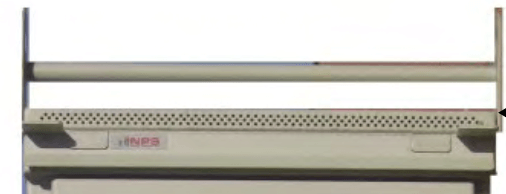
Solar shield (the top plate)
DIN rails are used to mount circuit breakers in equipment enclosures used in industrial applications.
We also make casters, thermometers, light switches, lifting eyes, operator devices, and purpose-specific features like keypads and heat exchangers.
To learn more, feel free to Contáctenos for more information about all the different features and accessories we offer! We will also provide any custom feature you request.
Do locks, windows, vents, and hinges lower the IP rating?
Yes, features like vents, windows, and locks do somewhat compromise the IP rating, but there are ways around it.
But KDM overcomes this difficulty, offering you some of the best enclosures for your business.
We incorporate various gaskets, PU seals, latches, and filters to balance out the IP rating.
What different types of steel can be used for IP56 enclosures?
The materials used for IP56 enclosures aren’t different from materials used for other types of enclosures.
Se pueden hacer a partir de acero carbono, acero galvanizado, y acero inoxidable – generalmente de los grados 304, 316 o 316L.
El acero al carbono suele ser más opaco que el acero inoxidable.
También es magnético y más maleable ya que solo tiene hierro y carbono.
This steel is also prone to corrosion.
El acero inoxidable se crea añadiendo cromo, níquel y molibdeno a la aleación de hierro y carbono.

Acero inoxidable vs acero galvanizado
Los grados de acero 304 y 316 difieren en el contenido de todos los aditivos.
Grade 316 is slightly stronger and resistant to saline and acidic water because of molybdenum.
But grade 304 is cheaper and more common.
Grade 316L has a lower carbon content, making it a little bit stronger.
Acero galvanizado Está recubierto con una capa protectora de zinc que evita la corrosión.
We have galvanized steel enclosures, and this metal is vulnerable to salt water.
Please note that galvanized steel is more expensive and heavier than stainless steel.
Another type of steel that can be used is cold-rolled steel, which is thinner and denser than normal steel – and thus, it is stronger.
Si desea obtener más información, Envía tu consulta ¡Ahora para una consulta!
Is fiberglass a good material for IP56 enclosures?
Fibra de vidrio Es muy fuerte, puede disipar el calor y aísla la electricidad, reduciendo el efecto de interferencia y la posibilidad de descarga.
Está hecho de fibras de vidrio colocadas en plástico.
Fiberglass enclosures can be up to IP65, so IP56 is possible.
Fiberglass is also effective against corrosion.

Caja de fibra de vidrio
Speaking of plastics, we can include windows made from polycarbonate and ABS.
El policarbonato es más resistente a la corrosión, mientras que el ABS es más barato.
Why use aluminum for IP56 enclosures?
IP56 enclosures can also be made from aluminum alloys.
They are not necessarily better than steel alloys but can be depending on what you are going for and what are your needs.
Al igual que los grados de acero, las aleaciones de aluminio pueden ser de la serie 5052 o 6061.

Aluminio vs acero inoxidable
Ambos son livianos, pero el 5052 es más soldable, mientras que el 6061 tiene una mayor resistencia a la corrosión.
Además, el 6061 es más caro.
El aluminio tiene una capa de óxido en la parte superior que evita cualquier corrosión.
This material is especially good for enclosures exposed to solvents, petrochemicals, some acids, most sulfates, and nitrates.
So, if you are looking to put IP56 enclosures in such mildly hazardous environments, aluminum is good for that.
What paints and coatings can be used for IP56 enclosures?
Nuestros recintos están bien protegidos, pero el revestimiento adecuado también puede aumentar su protección.
Puedes elegir capas de pintura esmaltada o en polvo en cualquier color.
Pintura de esmalte Tiene un acabado brillante y es resistente a diferentes condiciones climáticas.
Las pinturas de esmalte específicas, como el esmalte epoxi y el esmalte PU, se utilizan comúnmente para carcasas industriales, ya que son resistentes a la corrosión.
Pintura en polvo is deposited with the electrostatic force and is quicker and easier than enamel.

Acabados con recubrimiento en polvo
También ofrecemos recubrimientos anodizados y alodizados.
Anodizado El recubrimiento utiliza ánodos para oxidar un metal, generalmente aluminio, para aumentar su espesor y lograr una mejor resistencia a la corrosión.
El acero normalmente no se anodiza porque esto puede acelerar la corrosión del metal.
Recubrimiento de alodina, también conocido como recubrimiento de conversión de cromato, se utiliza para imprimar acero y aluminio para pintar, así como para prevenir la corrosión.
También tiene una apariencia más flexible, lo que le brinda la opción de acabados brillantes y mate.

Recubrimiento de alodine
Este es un proceso más económico que el anodizado y se puede reconocer por su característico tono amarillo verdoso, a menos que esté pintado encima.
Podemos proporcionar cualquier recubrimiento en cualquier color y acabado, por lo que Contáctenos ¡hoy!
How do you customize the symbols or writing on an IP56 enclosure?
Nuestros servicios de personalización incluyen grabado y serigrafía.
Silk Screening is the easiest and most affordable method to customize an enclosure.
Any flat side of the enclosure can be silk-screened with labeling operators, serial number, your company name, and logo.
Examples of operators include emergency stop and gas detection among others.
Sin embargo, la serigrafía sobre metales como el acero inoxidable o el aluminio puede desgastarse o rayarse, pero una capa de polvo transparente ayuda a evitarlo.

Serigrafía
El grabado de la caja es otro método para personalizar sus cajas.
Esta opción es más costosa y requiere más tiempo, pero también es más a largo plazo que la serigrafía.
Se elimina un poco de metal de la superficie de la carcasa en el diseño del logotipo o símbolo.
Usually, about 0.005 inches or 0.010 inches of metal is removed.
Una vez retirado el metal, se rellena con pintura epoxi del color que se desee según sus necesidades.
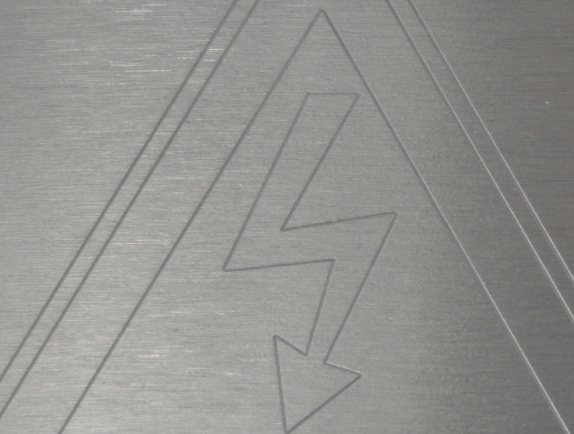
Grabado
There can also be anti-graffiti and anti-poster coatings to protect your IP56 enclosure from vandalism.








